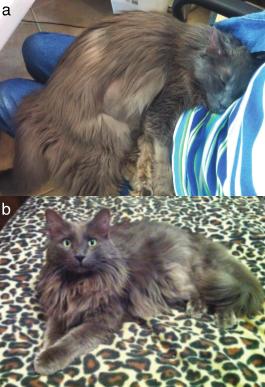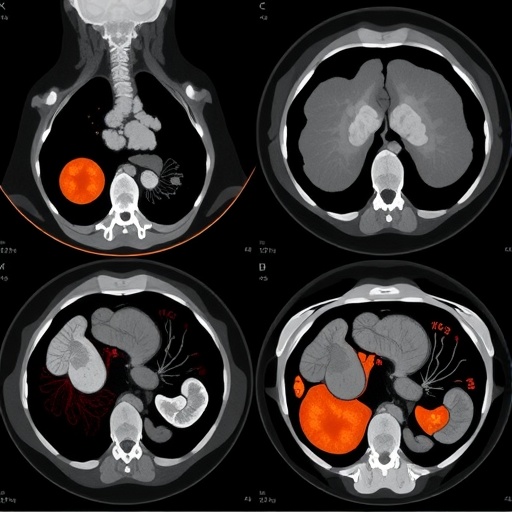
Credit: Adel Gastle
The emergence of exotic diseases such as Ebola and SARS (severe acute respiratory syndrome) in people has prompted intensive research into new drug treatments, and this is indirectly bringing benefit to cats. Feline infectious peritonitis (FIP) is one of a number of chronic viral infections of cats that resemble those in people, and is estimated to kill up to 1.4% of cats around the world. The infectious agent is a mutant coronavirus (FIPV) that is notoriously difficult to control: the parent enteric coronavirus is present in virtually all catteries and shelters and is shed by 60% or more of pet cats from multi-cat households,1 and vaccines are ineffective.
Among the most promising treatments against emerging viruses in humans is ‘GS-5734’, one of the small-molecule antivirals targeting specific proteins involved in RNA virus replication. In studies, it has proven effective in preventing Ebola in rhesus monkeys and inhibiting coronaviruses both in tissue culture and in mouse infection models. It was these findings that brought it to the attention of a team of veterinary researchers in the USA, led by Professor Niels Pedersen of the University of California, Davis. Their own initial studies involving experimental FIP showed that the less chemically complex ‘GS-441524’, the parent nucleoside of GS-5734, was highly effective, opening the way for a field trial in cats with naturally occurring FIP. The results have been striking, and were published in the Journal of Feline Medicine and Surgery (JFMS) on 13 February 2019.*
Thirty-one cats, ranging in age from 3-73 months, were enrolled in the study, and 26 completed the planned 12 weeks or more of treatment; the remainder died or were euthanized due to their severe disease. For these 26 cats, the clinical response was dramatic: fever usually resolved within 12-36 h, concurrent with a marked improvement in appetite, activity levels and weight gain. In cats with the more common effusive or ‘wet’ form of FIP, abdominal effusions rapidly disappeared, starting at around 10-14 days after commencing treatment. Encouragingly, and somewhat unexpectedly, cats with non-effusive (‘dry’) FIP and older cats responded as well to GS-441524 treatment as did cats with effusive FIP and young cats. The safety profile of GS-441524 was likewise impressive.
Currently, 24 of the 26 cats remain healthy, with one having succumbed to FIP disease and one to unrelated heart disease. Eighteen of these cats underwent just one round of treatment; the remaining eight suffered disease relapses, but these were successfully treated with a further (in two cases, a third) round of treatment at a higher dose.
Previously the prospects for cats with FIP were bleak. In a seminal review paper on FIP published in JFMS a decade ago, Professor Pedersen stated: ‘no treatment has proven effective in curing cats of FIP, in spite of the claims. Cats that develop FIP inevitably die of their disease in days, weeks or months.’1 Now, as he approaches the end of his professional career, Professor Pedersen is considerably more optimistic: ‘FIP has been my fascination for the past 50 years and I am fortunate to have reached a final stage in my career having identified safe and effective antiviral drugs. We now know that small molecules targeting specific steps in RNA virus replication are capable of safely curing various forms of FIP.’ However, he cautions: ‘It must be emphasized that the field trial we report was for proof-of-concept and the results cannot be immediately translated into commercially available products. Unfortunately, the real hope provided by these initial trials has increased, and not decreased, the desperation of owners to seek out these new drugs on the black market. As eventful as these discoveries may be, there is still much more about FIP to discover. I would like to thank all of the people, organizations and owners who have assisted in my research over this half century and leave remaining questions and associated discoveries for my fellow FIP researchers.’
###
Reference
1 Pedersen NC. Review of feline infectious peritonitis virus infection: 1963-2008. J Feline Med Surg 2009; 11: 225-258.
*Pedersen NC, Perron M, Bannasch M, et al. Efficacy and safety of the nucleoside analog GS-441524 for treatment of cats with naturally occurring feline infectious peritonitis. J Feline Med Surg. Epub ahead of print 13 February 2019. DOI: 10.1177/1098612X19825701. This article is free to read here.
Picture: Bubba, one of the study cats, who had been found as an abandoned 3-week-old kitten by his owner in Florida, USA. At the age of 7, having been diagnosed with abdominal non-effusive FIP, he was enrolled in the GS-441524 treatment study. (a) Bubba pictured in May 2017, just before treatment commenced; he was sick and anorexic, weighing 6 kg (13.5 lb). One week into the 12-week treatment course his owner reported he was ‘eating on his own, alert, energetic and playful.’ (b) Bubba, pictured in January 2018, weighing 9.3 kg (20.5 lb). Credit: Adel Gastle
About the Journal of Feline Medicine and Surgery
The Journal of Feline Medicine and Surgery (jfms.com) is the official journal of the International Society of Feline Medicine (ISFM) and the American Association of Feline Practitioners (AAFP), and is published by SAGE Publishing.
Media Contact
Margaret Melling
[email protected]
44-017-478-71872
Related Journal Article
http://dx.




